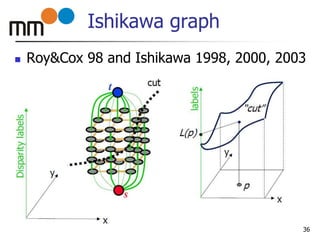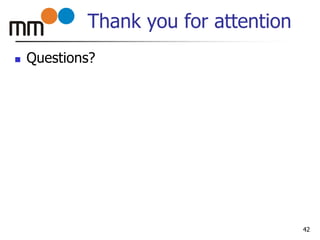Optimization algorithms for solving computer vision problems
- 1. Optimization algorithms for solving computer vision problems Olgierd Stankiewicz Krzysztof Wegner Chair of Multimedia Telecommunications and Microelectronics Poznań University of Technology Poznań, April 2015
- 2. Computer Vision Problems Segmentation Assigning each pixel of the image to a certain segment Depth estimation Assigning a depth value to each pixel of the image 2
- 3. Computer Vision Problems Image stitching Assigning each pixel of the output image to a certain source image (transformed) Image restoration Assigning to each pixel of the output image a colour from the source image 3
- 4. Computer Vision Generalization Can be seen as labeling problem Assigning to each pixel of the output image a label defined in a certain way Label is an index from all possible answers Segment index Disparity Stitched image index Colour 4 1 2 5 5 6 2 1 4 3 5 3 4 4 1 8 3 5 4 0 4 7 2 9 6 7 2 2 4 5 3 6 8 2 1 4 0 0 3 4 3 𝑑 𝑥,𝑦 - label
- 5. Energy minimization There are many ways to label pixels in an image Which one is better? What it the goal? Energy minimalization problem 5 𝐸 𝑓0,0, 𝑓0,1, … , 𝑓 𝑊−1,0, 𝑓1,0, … … 𝑓 𝑊−1,𝐻−1 = 𝑚𝑖𝑛 𝑓𝑥,𝑦 – label for pixel x,y 𝑊, 𝐻 – image size
- 6. Simple? Not simple! Multivariable, e.g. 1920 x 1080 ≈ 2M varables Energy function can be very complex Non-monotonic Non-linear Implicit, with inter-label references Classic Stepest Desent Not too efficient Would probably not find the solution anyway 6
- 7. Efficient minimalization Special class of energy functions can be minimalized more efficiently Energy function decomposed into sum of: Unary terms Pairwise terms Unary and pairwise terms 7 𝐸 = 𝑥,𝑦 𝑈 𝑥,𝑦 𝑓𝑥,𝑦 𝐸 = 𝑥,𝑦,𝑧,𝑤 𝑇𝑥,𝑦,𝑧,𝑤 𝑓𝑥,𝑦, 𝑓𝑧,𝑤
- 8. Efficient minimalization Even more efficient when Binary labeling problem Function argument can be 0 or 1 Energy function is convex (submodular) Triangle inequality E.g. Monotone Linear (Planar etc.) 8 𝑥 + 𝑦 ≤ 𝑥 + |𝑦|
- 9. Example 1 Binary segmentation Labels 𝑓𝑥,𝑦 are black(0) and white (1) Input image 𝐼 𝑥, 𝑦 𝜖[0..1] | ∙ | Linear luminance penalty Regularization 4-pixel neighbourhood |∙| Linear segment index difference penalty 9 Left Right Top Bottom dx,y dx,y-1 dx,y+1 dx-1,y dx+1,y } Unary terms Pairwise terms 𝐸 = 𝑥,𝑦 𝐼 𝑥, 𝑦 − 𝑓𝑥,𝑦 + 𝑓𝑥,𝑦 − 𝑓𝑥+1,𝑦 ∙ 𝛼 + 𝑓𝑥,𝑦 − 𝑓𝑥−1,𝑦 ∙ 𝛼 + 𝑓𝑥,𝑦 − 𝑓𝑥,𝑦−1 ∙ 𝛼 + 𝑓𝑥,𝑦 − 𝑓𝑥,𝑦+1 ∙ 𝛼
- 10. Example 2 Depth estimation Labels 𝑑 𝑥,𝑦 are disparities Image matching between pixels in the left/right image | ∙ | Linear luminance penalty Regularization 4-pixel neighbourhood |∙| Linear disparity difference penalty 10 Left Right Top Bottom dx,y dx,y-1 dx,y+1 dx-1,y dx+1,y } Unary terms Pairwise terms 𝐸 = 𝑥,𝑦 𝐿 𝑥 + 𝑑 𝑥,𝑦, 𝑦 − 𝑅 𝑥, 𝑦 + 𝑑 𝑥,𝑦 − 𝑑 𝑥+1,𝑦 ∙ 𝛼 + 𝑑 𝑥,𝑦 − 𝑑 𝑥−1,𝑦 ∙ 𝛼 + 𝑑 𝑥,𝑦 − 𝑑 𝑥,𝑦−1 ∙ 𝛼 + 𝑑 𝑥,𝑦 − 𝑑 𝑥,𝑦+1 ∙ 𝛼
- 11. Optimization algorithms Viterbi State transitions Well knowm Belief Propagation Message passing Presented before Graph Cuts 11 Node of Markov field, defined by all possible disparities and their probabilities Two-directional connection between nodes of Markov field ........ ........ One-directional connection between nodes of Markov field a) b) each-to-each each-to-each Transition between the states
- 12. Graph Cuts Graph Cuts can be used for efficient unary and pairwise energy minimization Min Cut == Max Flow theorem Solving of Minimal Cut problem in a graph is equal to solving of Maximal Flow problem in the same graph Efficient generic algorithms Expression of energy minimization problem as MinCut 12
- 13. Graphs Nodes Edges Capacity Flow (in a particular solution) Constraints Flow ≤ Capacity Flow conservation E.g. communication network 13
- 14. Minimum s-t cuts Special nodes S - Source T - Sink (Terminal) Algorithms Augmenting paths [Ford & Fulkerson, 1962] Push-relabel [Goldberg-Tarjan, 1986] 14
- 15. Augmenting Paths Find a path from S to T along non-saturated edges Increase flow along this path until some edge saturates 15
- 16. Augmenting Paths Find next path Increase flow 16
- 17. Augmenting Paths Iterate until all paths from S to T have at least one saturated edge 17
- 18. Example Let’s assume a graph Nodes: s,o,p,q,r,t Flow=0 18 s t o p q r sink terminal 0/3 0/3 0/2 0/3 0/2 0/3 0/4 0/2
- 19. Example Path 1, Free Capacity:2 19 s t o p q r sink terminal 0/3 0/3 0/2 0/3 0/2 0/3 0/4 0/2
- 20. Example Path 1, Add Flow:2 20 s t o p q r sink terminal 2/3 0/3 0/2 2/3 2/2 0/3 0/4 0/2
- 21. Example Path 2, Free Capacity:1 21 s t o p q r sink terminal 2/3 0/3 0/2 2/3 2/2 0/3 0/4 0/2
- 22. Example Path 2, Add Flow:1 22 s t o p q r sink terminal 3/3 0/3 0/2 3/3 2/2 1/3 1/4 0/2
- 23. Example Path 3, Free Capacity:0 23 s t o p q r sink terminal 3/3 0/3 0/2 3/3 2/2 1/3 1/4 0/2
- 24. Example Path 4, Free Capacity:2 24 s t o p q r sink terminal 3/3 0/3 0/2 3/3 2/2 1/3 1/4 0/2
- 25. Example Path 4, Add Flow:2 25 s t o p q r sink terminal 3/3 2/3 0/2 3/3 2/2 3/3 1/4 2/2
- 26. Example - flow Flow from sink: 5 = Flow to terminal: 5 Maximal flow = 5 26 s t o p q r sink terminal 3/3 2/3 0/2 3/3 2/2 3/3 1/4 2/2
- 27. Example - cut All possible cuts 27 s t o p q r sink terminal 3 3 2 3 2 3 4 2 6 8 7 10 8 5 5
- 28. Example – minimal cut Minimal Cut = 5 Two equi-optimal cuts 28 s t o p q r sink terminal 3 3 2 3 2 3 4 2 5 5
- 29. Complexity V – number of nodes E – number of edges Augmenting paths 𝑂(𝑉 ∙ 𝐸) via bucket data sorting Kolmogorov 𝑂 𝑉 ∙ 𝐸 Push-relabel 𝑂 𝑉2 𝐸 But parrarelizable 29
- 30. Graph construction 30 min 𝑓1,𝑓2,…,𝑓𝑛−1,𝑓𝑛 𝐸 𝑓1, 𝑓2, … , 𝑓𝑛−1, 𝑓𝑛 𝐸 𝑓1, 𝑓2, … , 𝑓𝑛−1, 𝑓𝑛 = 𝑖 𝐸𝑖 𝑓𝑖 + 𝑖 𝐸𝑖,𝑗 𝑓𝑖, 𝑓𝑗 Each cut throught the graph must represent energy (some potential solution) The graph is a sum of elementary graphs for each energy term
- 31. Graph construction 31 min 𝑓1,𝑓2,…,𝑓𝑛−1,𝑓𝑛 𝐸 𝑓1, 𝑓2, … , 𝑓𝑛−1, 𝑓𝑛 𝐸 𝑓1, 𝑓2, … , 𝑓𝑛−1, 𝑓𝑛 = 𝑖 𝐸𝑖 𝑓𝑖 + 𝑖 𝐸𝑖,𝑗 𝑓𝑖, 𝑓𝑗 𝐸𝑖 1 − 𝐸𝑖 0 𝑓=1s 𝑓=0t 𝐸𝑖 0 − 𝐸𝑖 1 𝑓=1s 𝑓=0t 𝐸𝑖 1 > 𝐸𝑖 0 𝐸𝑖 1 < 𝐸𝑖 0 𝑓𝑖=0 𝑓𝑖=1 𝐸𝑖 𝑓𝑖 2 3 𝑣𝑖 𝑣𝑖
- 32. Graph construction x 32 min 𝑓1,𝑓2,…,𝑓𝑛−1,𝑓𝑛 𝐸 𝑓1, 𝑓2, … , 𝑓𝑛−1, 𝑓𝑛 𝐸 𝑓1, 𝑓2, … , 𝑓𝑛−1, 𝑓𝑛 = 𝑖 𝐸𝑖 𝑓𝑖 + 𝑖 𝐸𝑖,𝑗 𝑓𝑖, 𝑓𝑗 𝐸𝑖,𝑗 1,0 − 𝐸𝑖,𝑗 0,0 𝑓=1s 𝑓=0t 𝑣𝑖 𝑣𝑗 𝐸𝑖,𝑗 1,0 − 𝐸𝑖,𝑗 1,1 𝐸𝑖,𝑗 0,1 + 𝐸𝑖,𝑗 1,0 − 𝐸𝑖,𝑗 0,0 -𝐸𝑖,𝑗 1,1 𝐸𝑖,j 𝑓𝑖, 𝑓𝑗 𝑓j=0 𝑓j=1 𝑓𝑖=0 2 3 𝑓𝑖=1 4 5
- 33. Graph construction 33 𝐸𝑖,j 𝑓𝑖, 𝑓𝑗 𝑓j=0 𝑓j=1 𝑓𝑖=0 𝐸𝑖,j 0,0 𝐸𝑖,j 0,1 𝑓𝑖=1 𝐸𝑖,j 1,0 𝐸𝑖,j 1,1 Assume that 𝐸𝑖,j 0,0 is the biggest 𝐸𝑖,j 0,0 𝐸𝑖,j 0,1 𝐸𝑖,j 1,0 𝐸𝑖,j 1,1 =𝐸𝑖,j 0,0 + 0 𝐸𝑖,j 0,1 -𝐸𝑖,j 0,0 𝐸𝑖,j 1,0 -𝐸𝑖,j 0,0 𝐸𝑖,j 1,1 -𝐸𝑖,j 0,0 =𝐸𝑖,j 0,0 + = 0 0 𝐸𝑖,j 1,0 -𝐸𝑖,j 0,0 𝐸𝑖,j 1,0 -𝐸𝑖,j 0,0 + 0 𝐸𝑖,j 1,1 -𝐸𝑖,j 1,0 0 𝐸𝑖,j 1,1 -𝐸𝑖,j 1,0 + 0 𝐸𝑖,j 0,1 + 𝐸𝑖,j 1,0 − 𝐸𝑖,j 0,0 − 𝐸𝑖,j 1,1 0 0 +
- 34. Graph construction 34 min 𝑓1,𝑓2,…,𝑓𝑛−1,𝑓𝑛 𝐸 𝑓1, 𝑓2, … , 𝑓𝑛−1, 𝑓𝑛 𝐸 𝑓1, 𝑓2, … , 𝑓𝑛−1, 𝑓𝑛 = 𝑖 𝐸𝑖 𝑓𝑖 + 𝑖 𝐸𝑖,𝑗 𝑓𝑖, 𝑓𝑗 𝑓=1s 𝑓=0t 𝑣1 𝑣 𝑛𝑣 𝑛−1𝑣2 𝑣…
- 35. Multilabel energy 𝑓𝑖 can be not only binary Multilabel The are two graphs constructions commonly used Ishikawa multilabel graph Move graph construction 35
- 36. Ishikawa graph Roy&Cox 98 and Ishikawa 1998, 2000, 2003 36
- 38. Ishikawa graph 38 Many nodes required at once Many edges Very slow Restricted only to linear, pairwise terms
- 39. a-expansion Solves series of binary problems 𝑓𝑖 can be: 0 – keep the current label 1 – change the label to a 39
- 40. a-expansion Start with any* initial solution For each label a in any (e.g. random) order Compute optimal a-expansion move (binary problem) Reject the move if there is no energy decrease Stop when no expansion move would decrease energy 40
- 41. a-expansion Typically two cycles throught all labels are required *Depends on the initial solution At given iteration „some” solution is known In Ishikawa only after solving the whole graph 41
- 42. Thank you for attention Questions? 42









![Example 1
Binary segmentation
Labels 𝑓𝑥,𝑦 are black(0) and white (1)
Input image 𝐼 𝑥, 𝑦 𝜖[0..1]
| ∙ | Linear luminance penalty
Regularization
4-pixel neighbourhood
|∙| Linear segment index difference penalty
9
Left Right
Top
Bottom
dx,y
dx,y-1
dx,y+1
dx-1,y dx+1,y
}
Unary terms
Pairwise terms
𝐸 =
𝑥,𝑦
𝐼 𝑥, 𝑦 − 𝑓𝑥,𝑦
+ 𝑓𝑥,𝑦 − 𝑓𝑥+1,𝑦 ∙ 𝛼
+ 𝑓𝑥,𝑦 − 𝑓𝑥−1,𝑦 ∙ 𝛼
+ 𝑓𝑥,𝑦 − 𝑓𝑥,𝑦−1 ∙ 𝛼
+ 𝑓𝑥,𝑦 − 𝑓𝑥,𝑦+1 ∙ 𝛼](https://image.slidesharecdn.com/gc-20150413-1300-170317210914/85/Optimization-algorithms-for-solving-computer-vision-problems-9-320.jpg)




![Minimum s-t cuts
Special nodes
S - Source
T - Sink (Terminal)
Algorithms
Augmenting paths [Ford & Fulkerson, 1962]
Push-relabel [Goldberg-Tarjan, 1986]
14](https://image.slidesharecdn.com/gc-20150413-1300-170317210914/85/Optimization-algorithms-for-solving-computer-vision-problems-14-320.jpg)



























